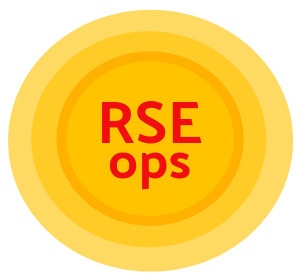
Scientific Software for RSE-ops vs. DevOps
Installation of scientific software on HPC is a non-trivial task. To maximize the efficiency of any piece of software and maximally utilize an underlying resource, it’s typically ideal to install it natively on the system, as opposed to a containerized environment, which is arguably a foundation of modern DevOps [1]. However, studies are increasingly showing that containerization overhead is in fact low [2], and so the main distinguishing difference between using containers ("DevOps") and native install (traditional HPC) is ultimately the portability of the software, and that HPC software must be built across a wide set of architectures. RSE-ops is an interesting combination of these two realities, as containers are widely used on HPC [3], [4], [5] but the environments must also support having complex software stacks alongside one another without conflicting dependencies. This means that modules are common [6], [7], and even modules paired with containers [8] and users are encouraged to "BYOE" or "bring your own environment" through containerization and local install in the case that the software can be installed in user space. Otherwise, the software must be requested to be installed by the administrators of the cluster.
Thus, the strategy for deployment of scientific software usually comes under the decision of the Linux administrators that manage the cluster. A piece of software or new technology can only be embraced when it is asked for heavily by users, and this ask is finally heard by the Linux administrators. While some large centers have separate teams for system admins and user support staff, smaller institutions tend to have a small group of people serving both roles. In practice, these over-burdened staff cannot devote extra time to learning new technologies and bringing more DevOps-like practices to their systems. Users of the systems, although they can control external services, don’t have control to do so either. This arguably is why DevOps practices have been slower to become part of high performance computing culture. Given the complexity of using software on HPC and the many different strategies for enabling users to run it, some trade-off between portability and performance is required. Due to limited permissions, users are not always empowered to install and run services like they can in the cloud. Using cloud resources for development (and embracing DevOps) gives users a lot more freedom because they typically do not need to ask for permission. Arguably, there is a learning curve to this knowledge, but also arguably, there is a learning curve for most new things that have the potential to improve a daily workflow.
Best Practices for Scientific Software
We argue that it should not be entirely the burden of Linux administrators to learn and adopt new practices, but rather they should have the support of Research Software Engineers (RSEs). If Linux administrators have little bandwidth left for testing, bench-marking, or otherwise working on research software, RSEs can step in to both understand the workings of the underlying system, but also the needs of the researchers or user-base. This is a a compelling example that demonstrates the need for Research Software Engineers (RSEs), who can not only better bridge the gap between the administrators and users of a system, but also can focus on defining best practices in systems, behavior, and software for using it. Adding this layer of best practices for automated builds, testing, organization, and deployment of scientific software on HPC is what we would define as RSE-ops.
Given the current ecosystem where RSEops best practices are not known, we can make suggestions that best handle this dual need for modularity or containers and native installations. For installing scientific software, the package managers spack and software build and installation framework easybuild or module managers LMOD and environment modules [6], [7] are most commonly used to install and manage scientific software. Container technologies are also used to allow researchers to use containerization [4], [5], [3], [9]. Many of these tools allow flexibility to transition between tools, such as spack producing files to build containers, and containers installing software from spack [10]. Package managers are a strong collaborative framework because they provide a structured way for people to work together on software together.
- “Containers Intro.” https://www.oreilly.com/library/view/cloud-native-devops/9781492040750/ch01.html#containers-intro. [bibtex]
- A. Torrez, T. Randles, and R. Priedhorsky, “HPC Container Runtimes have Minimal or No Performance Impact,” in 2019 IEEE/ACM International Workshop on Containers and New Orchestration Paradigms for Isolated Environments in HPC (CANOPIE-HPC), 2019, pp. 37–42. [bibtex]
- “Singularity: Scientific containers for mobility of compute.” https://journals.plos.org/plosone/article?id=10.1371/journal.pone.0177459. [bibtex]
- “Charliecloud: unprivileged containers for user-defined software stacks in HPC.” https://dl.acm.org/doi/10.1145/3126908.3126925. [bibtex]
- “Podman - : A tool for managing OCI containers and pods.” Jan-2018. [bibtex]
- “LMOD.” https://lmod.readthedocs.io/en/latest/. [bibtex]
- “Environment Modules.” https://modules.readthedocs.io/en/latest/. [bibtex]
- “Singularity Registry HPC.” https://singularity-hpc.readthedocs.io. [bibtex]
- “Shifter.” https://github.com/NERSC/shifter. [bibtex]
- “Autamus.” https://autamus.io/. [bibtex]
